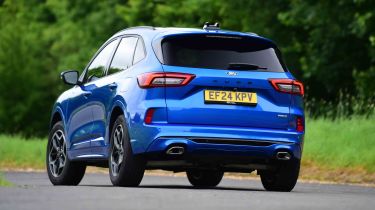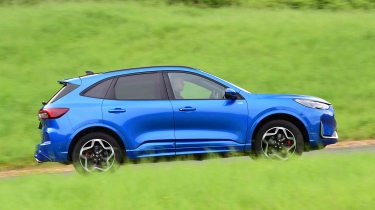Ford Kuga - Engines, performance and drive
The Ford Kuga offers strong fuel economy from its full hybrid and plug-in hybrid engines

Ford has fitted the third-generation Kuga with a strong range of engines and made it a family SUV that’s also great to drive. There’s MacPherson strut front suspension and a multi-link rear set-up that help with both comfort on longer journeys and agility when pressing on through the corners. When you need to rein it in, the brakes are strong.
The suspension stays comfortable and composed in most situations, although we did find the ride slightly too firm and bouncy on the ST-Line X version with its sporty suspension and larger alloy wheels. Smaller wheels go towards making the Kuga more refined.
A significant move forward for the Kuga is the adoption of mild-, full- and plug-in hybrid power, which help improve fuel consumption and reduce CO2 emissions. The mild-hybrid tech recoups power during braking and stores it in a small battery, which is then used to power an electric motor that assists when accelerating to reduce the demand on the engine and maximise efficiency when on the move. The full-hybrid operates similarly but includes a larger battery that can store more power, and a stronger electric motor that can move the Kuga under electric power alone for short distances at low speeds, improving fuel economy further.
Used - available now
However, the Kuga plug-in hybrid model is where you’ll find major savings in fuel consumption and less CO2 emitted from the tailpipe. It’s most effective when engaged in pure-EV mode, because the 2.5-litre petrol engine can be a little loud when it chips in. This isn’t helped by the CVT gearbox, which is typically noisy when accelerating hard – in fact, we’d prefer a regular automatic transmission to smooth things along.
0-62mph acceleration and top speed
The 1.5-litre EcoBoost petrol engine provides 148bhp and 240Nm of torque, and manages the 0-62mph sprint in 9.7s, with a top speed of 121mph.
Next up is the 2.5-litre FHEV hybrid, with the front-wheel drive model producing 178bhp and 200Nm of torque, and the four-wheel producing just as much torque, but with a little more power at 181bhp. The former gets from 0-62mph in 9.1 seconds, while the latter is a little quicker at 8.3 seconds. Both top out at 122mph.
The fastest Kuga is the 240bhp 2.5-litre PHEV plug-in hybrid, which completes the same sprint in 7.3 seconds and romps on to a top speed of 125mph.
Ford has fitted selectable driving modes as standard, so you can cycle between settings designed to cater for eco, sporty and off-road driving.













